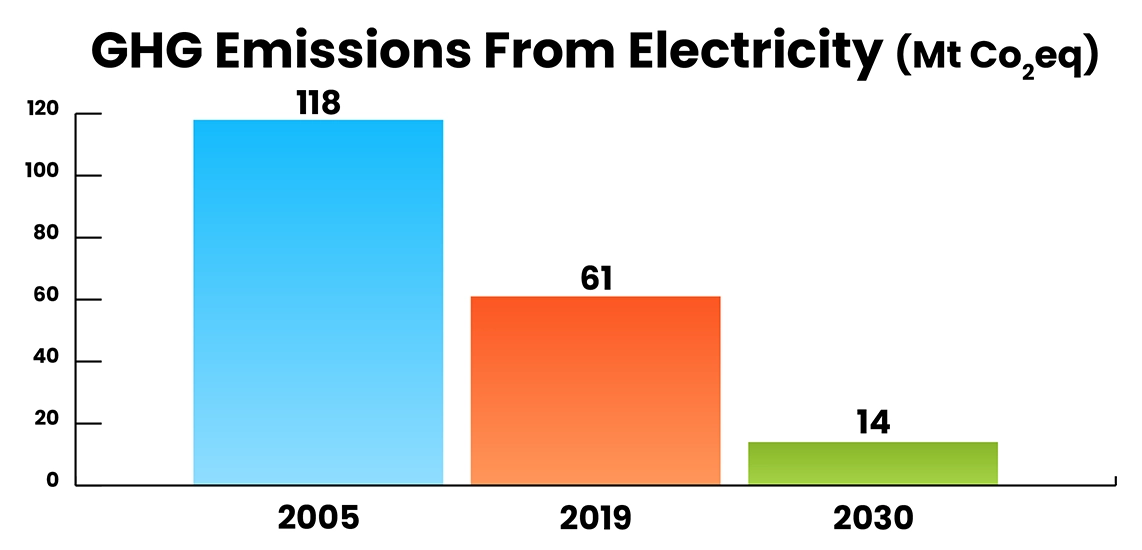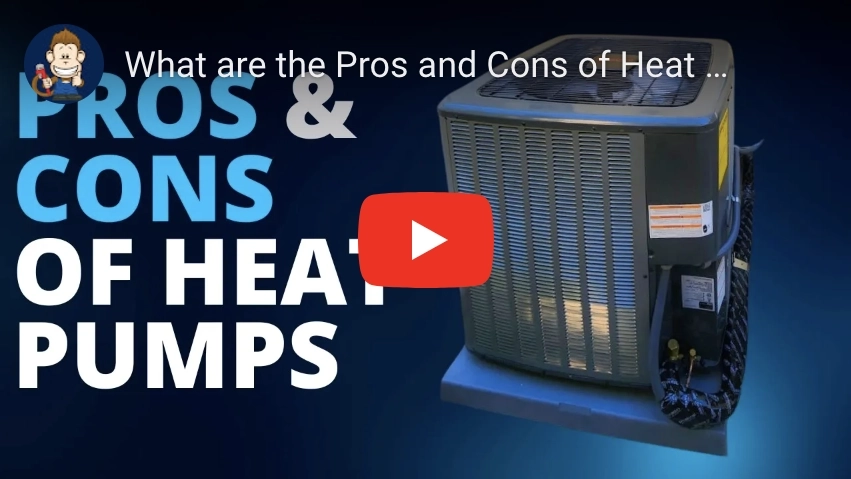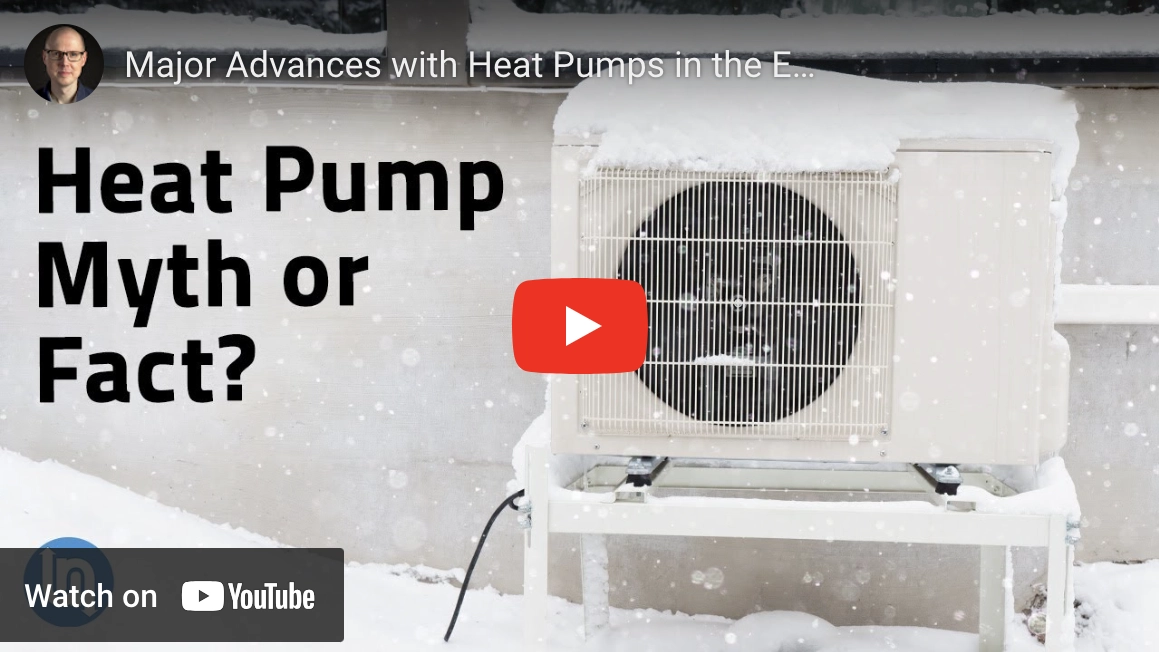Areas of Action: Your Home
Most people in Canada still heat their homes using fossil fuels (natural gas, oil, or propane) which directly emits greenhouse gases into the air.
Shifting our homes away from fossil fuel-based space heating is one of the most impactful ways we — as individuals — can reduce our emissions and it is one of the changes that everyone will undergo at some point. It’s a matter of ‘when’ not ‘if’.
Putting this into your 1–6 year plan will go a long way to reducing your footprint if you use fossil fuels for home heating and it will directly help Canadians stay aligned to our Net Zero 2050 goal.
There are also ‘smaller rock’ changes you can make in your home and property that will help drive towards Net Zero 2050 and a more sustainable, low carbon future, some of which are described below.
What needs to change?
• Fossil fuel energy (home heating if currently using propane, oil, natural gas; home appliances that use gas such as a water heater, dryer, stove, fire tables, lawn mowers, etc., fossil fuel-based power for the electricty grid)
• High intensity, inefficient energy use (energy inefficient buildings)
• Clean energy (electric heat pumps, electric water heaters, electric appliances, zero emissions electricity grid)
• Efficient energy use (increased energy efficiency in buildings)
• Reliable energy (better energy demand management, distributed energy sources, a mix of clean energy sources and energy storage)
Why is this so important?
Home energy alone accounts for more than a quarter of household emissions in Canada.
All emissions reductions scenarios for Canada involve a shift to clean electricity and electrification of buildings.
Canada has one of the cleanest grids in the world already; our grid is about 84% non-emitting overall already — and some Provinces use over 90% non-emitting electricity — so electrifying your heat sources and appliances will contribute significantly to your carbon reduction goals today.
Why so urgent?
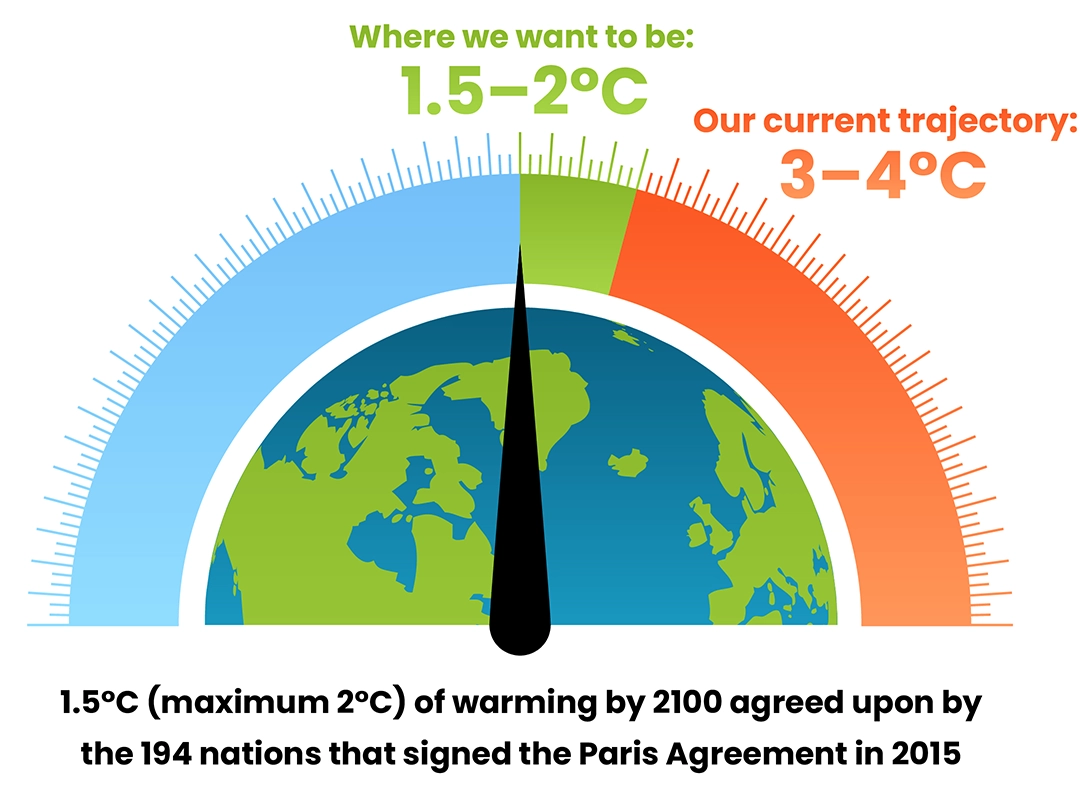
There is a rapidly narrowing window of time to implement existing commitments and raise ambition2. See Why So Urgent?
As per the Paris Agreement and subsequent IPCC modelling and research updates, we need to reduce our emissions by 43% below 2019 levels by 2030 in order to have a good chance of hitting Net Zero emissions by 2050 and avoiding the worst impacts of climate change.
Canada’s Plan
Canada has a 2030 plan3 that, if successful, can result in a 40% reduction in emissions (from our 2005 levels). But for some initiatives, the government can only set the stage and provide assistance — individuals and the private sector need to help with the implementation of the plan.
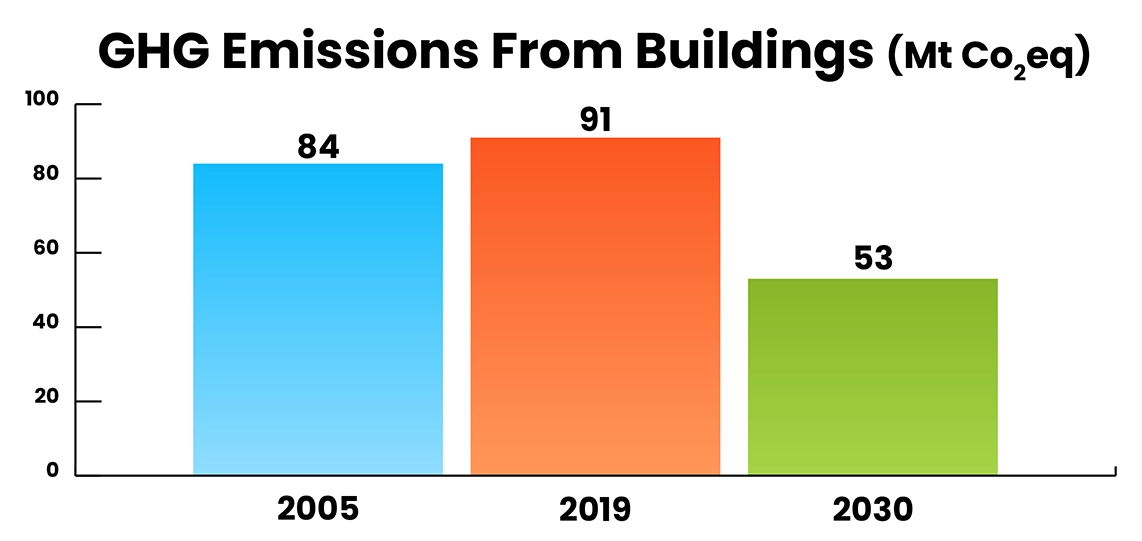
37% Reduction in Emissions Goal
By 2030, more than 10% of home heating in Canada must come from heat pumps to align with Canada’s climate targets4.
Main areas of action for your climate action plan

Install a heat pump
This is one of the most impactful changes you can make to reduce your personal Carbon Footprint and align to Canada’s Net Zero 2050 plan.
Thankfully, it is a once and done (or ‘once in every 15–20 years’ and done) change that you can plan for and ideally implement within the next 1–6 years (sooner is obviously better if possible.)
What is a heat pump?
A heat pump extracts heat from a source — air, the ground, water, waste — amplifies it and transfers it where it is needed.

Because it is transferring heat, rather than having to generate it, it is more efficient than other sources of energy. It also means that heat pumps can act as air conditioners as well, by moving heat in the opposite direction.14
There are a few different kinds to choose from based on
a) where the energy comes from (ground source, air source)
b) climate suitability (modern conventional, cold climate)
c) optional backup heating (electric or gas), and
d) type of distribution (ductless or duct based.)
All of them also include energy efficiency air conditioning7.
For most homes in Canada, a cold climate air source heat pump with an electric heat backup will be a good, energy efficient and cost-effective option.
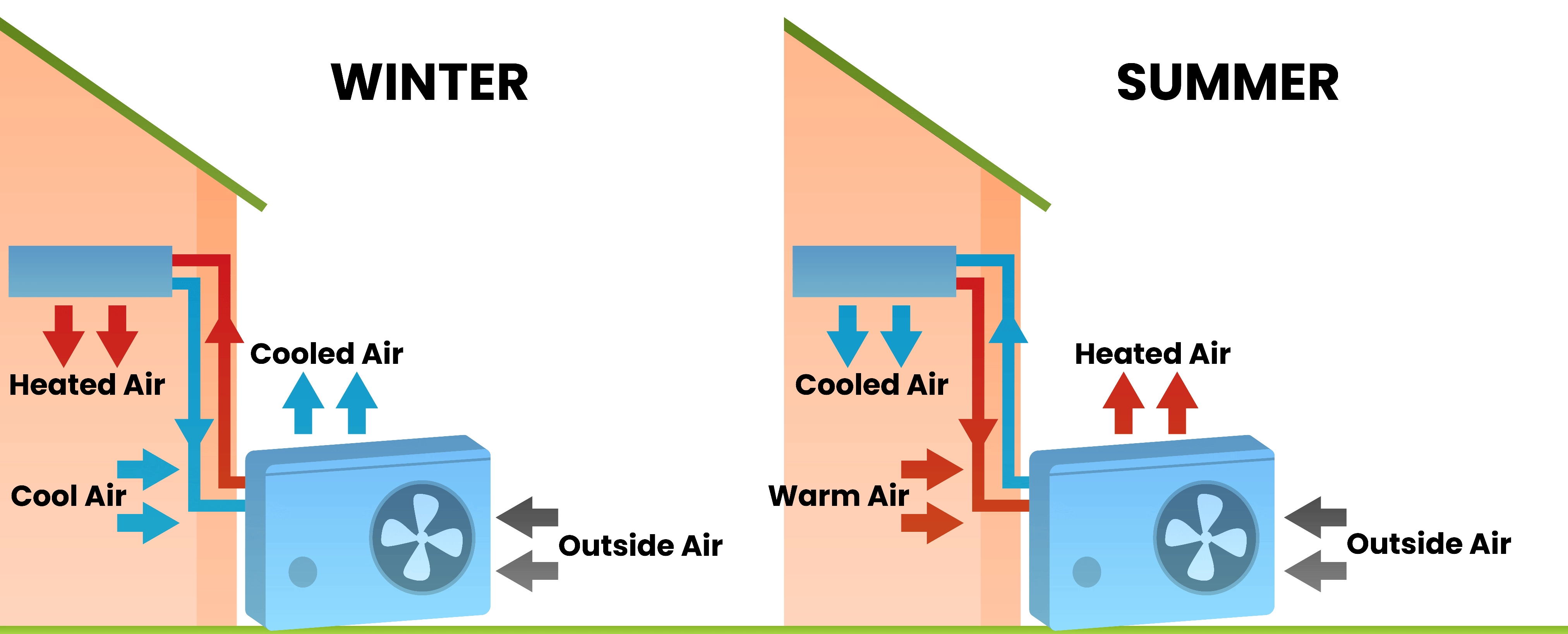
Will they work in Canadian winters?
Yes. Heat pumps have come a long way in the last decade both respect to efficiency and appropriateness for cold climates. Cold climate heat pumps typically work in temperatures down to -30°C.
Alternatively, if you live in an area that rarely gets colder than -10°C, using a modern standard heat pump with electric backup (ideally) for extremely cold days may work well for you too.
If you want to start making the transition before you give up a gas furnace or if you are considering adding or upgrading an air conditioner, you can also reduce your footprint somewhat by adding a heat pump as a supplement to gas heating to cover milder cold temperatures in spring and fall and provide your air conditioning in the summer8.
However, this may just prolong your use of fossil fuels for another decade or so at a time when we need deep and rapid reductions in fossil fuel use (see Why So Urgent?)
If you are replacing a furnace anyway, or are ready to make the move away from fossil fuels now (versus later), then a fully electric heat pump is the way to go.

But what about the costs?
Lifetime costs for air source heat pumps are a lot lower than those for oil or baseboard electric heat, and roughly on par or lower than natural gas for many homeowners. The resources below can help you make comparisons based on your situation.
The main cost barrier with an air source heat pump is the upfront purchase and installation cost. But when compared with the costs of a gas furnace plus an air conditioner (as heat pumps cover both needs), the cost differences are small or even disappear.
The upfront cost difference was largely subsidized by the Federal government through the Greener Homes Grant which is no longer available as of March 2024, and we will need to wait to see what additional funds future federal budgets will make available. You might flag this as an area of advocacy to encourage the government to make more funding available.
That said, you may still have access to other funding or financing from the Federal government, provincial or municipal governments, or financial institutions for heat pumps as well as for other energy efficiency upgrades. See financing your home energy transition plan below.

Make home efficiency improvements
The transition to clean home space heating and cooling will increase demand on the electricity grid.
Home efficiency improvements save you money over time in lower energy bills regardless of whether you are using fossil fuels or electricity. There are many resources for making your home more energy efficient. You can find a few examples below.
The main areas of improvement are:

Thermal envelope
(like insulation, air sealing, windows, and doors)

Appliance upgrades
to energy efficient options (see below)

Lighting and water usage
(toilets, tap aerators etc.)

Insulation of water heaters, pipes, etc.

Smart sensors, timers, smart thermostats
In addition to the federal government’s Greener Homes Grant, that provided financial support for energy efficiency improvements and electrification, some provinces, municipalities, cities and utilities also have implemented additional financial aids and other incentives to manage the cost and usage of electricity (for example, see links above in costs section.)
Utility providers may also offer a range of programs to help you manage your electricity usage which can save you money and decrease peak energy demand (when fossil fuels may be most needed to supplement non-emitting electricity.)
Given that offerings can change over time, it is worth checking in and ensuring you are aware of the currently available options for your area.

Replace gas and old electronic appliances and tools with efficient, modern electric alternatives
Gas appliances, such as water heaters, clothes dryers, stoves/ovens, gas lawn mowers and other yard tools, gas fireplaces etc. are long-term commitments that usually don’t get replaced until they either break down or get replaced in a renovation or other home upgrade.

If you want to reduce your footprint and can replace any gas appliances you may have early, fantastic. Otherwise, these are candidates for your longer-term plan and climate action commitment.
For some appliances, an interim plan may be to reduce their use/energy use as much as possible — for example, grabbing a blanket before turning on a gas fireplace, air drying more of your clothes, conserving water, insulating your water pipes to conserve heat, unplugging things when not in use, etc.
When you are ready to replace them, choose options with good energy efficiency ratings and properly recycle or donate old ones.
And for portable, occasionally used power tools and appliances, consider renting or sharing versus owning each one if that can work for you.
When considering a new air conditioner, think about adding a heat pump instead which covers efficient air conditioning as well as some or all of your space heating needs.
You may also want to consider using an energy monitor or reader to measure energy usage in your home and look for opportunities to improve efficiency.

Consider solar
Even in cold climates, residential solar is a highly effective way of reducing your energy use from the electricity grid, particularly where you can use a net metering (or microgeneration) program that allows you to ‘bank’ energy you create in the summer and use this credited energy in the winter when less solar power is generated.

If it is something you might consider, you can learn more about solar programs, options and companies across Canada and get an assessment done for your home (with cost estimates and payback period) via the following links:
You might also consider a solar water heater (learn more here.)
As with other energy transition initiatives, there may be funding or financing options for your jurisdiction.

Outside your home…
Your lawn and yard space: Although not a ‘large rock’ item from the perspective of emissions reduction per se, creating a more sustainable outdoor space nudges us towards a sustainable mindset more generally and can help to shift social norms and connect us more to nature.
Replace this…
• Astroturf
• Turf
• Pesticides
• Water intensive lawns
• Frequent mowing
• Low Biodiversity/lack of pollinators
• A gas lawn mower
With this…
• Native grasses, perennials and trees (check out David Suzuki’s grass alternatives here.)
• Low water requirements
• No pesticides
• Less maintenance
• Biodiversity and attraction of pollinators
• A vegetable garden (pots/raised beds)
• A beautiful social space to spend time in
• A manual or electric lawn mower


Renovation considerations
Renovations create a ton of waste and sometimes the use of new carbon intensive materials. However, renovating also affords a great opportunity to implement energy efficiency upgrades including insulation, better windows, air sealing, energy efficient appliances and lighting etc.
You can also consider more sustainable materials for things like new flooring etc. and replace gas appliances with electric options. Ask your contractor if they are using the most recent energy efficient building code standards to guide their recommendations as well.
And consider donating what you can from your old space rather than trashing it. Some salvagers will even come to you and pick up large items. Habitat for humanity, for example, will even salvage your entire kitchen and give you a tax receipt once resold, If it meets their salvaging criteria.

Note: if you happen to be having a new home built, this is a perfect opportunity to consider sustainability and get a significant reduction on your mortgage.
Financing your home energy transition plan
Although the Greener Homes Grant is no longer accepting new applications (as of March 2024), you may still have access to other funding or financing from the Federal government, or governments or financial institutions for heat pumps as well as for other energy efficiency upgrades.
Some Provincial and Municipality Programs
Clean Energy Incentives & Rebates Canada (Updated 2023)
Clean Energy Financing Programs Canada (Updated 2023)
Current Canadian Government Rebates for New Heating & Cooling Systems
More cities offering loans to cover upfront cost of heat pumps, solar
CleanBC Better Homes Low-Interest Financing Program
Energy Efficiency Loan Program – Online Application — Prince Edward Island
Other offers and tax credits — Hydro Québec
Some Financial Services Financing options
Provincial Credit Union — Energy Efficient Loans
RBC Energy Saver Loan
These options can change over time so you will need to check to see what is available where you live (and potentially advocate for options you see in other jurisdictions!)
It is understandable as well, to want to get value out of your current investment and to take time to research and plan the switch.
The key is to know your options in advance so that you are ready when the time comes to replace a fossil fuel furnace or boiler and/or take advantage of government incentives to switch.
While you wait, it is also worthwhile to tackle some of the energy efficiency improvements you can make to your home as these will lower your energy usage/emissions and costs both now and post transition to clean energy.
See more about financing your transition in Your Finances and Philanthropy.
Spotlight on Ottawa: In 2021, Ottawa launched a home energy efficiency retrofit loan program, offering residents low-interest 20-year loans of up to $125,000. Eligible improvements include thermal envelope upgrades, mechanical systems, renewable energy, EV chargers, and the addition of rental suites. Starting with $12 million in no- or low-interest loans, the program recapitalized in 2022 for $15 million by securing a loan agreement with VanCity Community Investment Bank.

Systemic change
Your voice and your vote matter.
Sharing your ideas and the changes you make with others (without judgement) can help them see a positive path forward as well. Sharing ideas that may not apply to you but are applicable for others you know (without judgement) may help drive systemic change.
If you see offerings and opportunities to reduce emissions in buildings in other jurisdictions, ask your representatives to consider them for where you live too. Many cities and municipalities are creating their own financial supports for residents to help them in their decarbonization journey (see above).
The more the better.

Notes on some broader systemic changes
The current capacity and energy mixes across Canadian Provinces can handle an increase in the rate of transition by individuals and businesses but as we continue to have population growth, increased affluence and a massive transition to clean energy in the coming decades we will need a lot of additional clean electricity.

The Federal government is developing legislation to transition to 100% non-emitting energy by 2035 and has factored in the increase in demand. The current draft regulation allows each Province to develop their own growth plan based on what makes sense in their jurisdiction, provided that it meets the federally set clean energy standards.
Additional capacity in most Provinces will include a mix of energy sources with expansions in renewable energy in most jurisdictions and, likely, an increase in microgeneration.
We aren’t alone. Canadians will benefit from similar transitions happening all across the globe. For example, at COP28, over 100 countries including Canada pledged to triple renewable energy by 2030 to keep the 1.5°C goal alive.
And as a Provincial example:
Canada’s 2023 Progress report on our 2030 Emissions Reduction Plan:
Success requires the participation of people like us.
Canada’s Net Zero building code strategy: Building Codes for New Buildings — Efficiency Canada
Note: It is far more cost effective to build efficient, fossil free homes new than to retrofit later.
Vehicle to Grid charging pilots and benefits in Canada (where vehicles can charge at cheaper, low grid use times and give/sell some energy back to the grid to support peak usage times)
Community solar projects — where you can buy-in to a solar project that feeds the grid and get a rebate on your energy bill — without having to have solar panels on your home: Nelson BC, Solar Generation
(This is more common in the United States but hopefully will expand in Canada too.)
Some of the recently funded smart grid projects across Canada: Smart Grid Program Review
It is far more cost effective to build efficient, fossil free homes new than to retrofit later.

In Canada (Montreal and Nanaimo): Montreal joins growing wave of cities banning natural gas

In the United States (California): What does a ban on natural gas appliances mean for homeowners?

Around the World: Why oil and gas heating bans for new homes are a growing trend

Ontario is going in the opposite direction: As cities ban natural gas to cut emissions, Ontario is expanding its gas network
We will continue to require a clean energy mix as we move to Net Zero. The degree to which we need to rely on what are considered to be ‘wild card’ solutions (because they are not commercially viable or scalable solutions at this time) and the specific sectors these solutions will be needed for is an active area of discussion and debate.
Here are some reasons why they should not stop the shift to electrification of residential space heating regardless of where we land with these solutions:

Hydrogen will be part of our clean energy future. However, it does not make any sense for home space heating for a number of reasons.
First, it is a more costly option than electric heat pumps and it is far less efficient9, taking 5–6x the electricity to produce heat from hydrogen as that of an efficient heat pump10.
Secondly, assuming we would get to the point of using renewable energy to make hydrogen rather than using fossil fuels to generate it, hydrogen can only be blended into natural gas infrastructure up to a proportion of 5–20% (depending on the existing infrastructure) so the emissions reduction capacity is low.
Beyond that, new or retrofitted pipelines and different home furnaces are required, with costs exceeding those of heat pumps11.
Finally, directing our tax money towards this expensive option risks the opportunity cost of failing to invest in cheaper options that are more effective at reducing emissions and also risks lock-in of expensive infrastructure — both of which of will delay the clean energy transition12.
Although hydrogen will play an important role in our Net Zero future — particularly in hard to abate processes and sectors, for direct residential heating it will be an expensive, highly inefficient, “too little too late” option.

Renewable natural gas and Carbon capture and storage (CCS) — these technologies will also likely have a place in our Net Zero world but again, it makes more sense to use them for hard to abate sectors than to rely on them for direct home heating.
Electrification is a cheaper and readily available option that can be scaled to meet demand. Affordable, scalable versions of Renewable Natural Gas and CCS solutions are nowhere near in sight and the capacity that is developed for these technologies will be needed for hard to abate sectors.13
Summary of potential actions
• Buy a heat pump
• Replace gas appliances and tools and inefficient electronics
• Improve home efficiency
• Decrease your energy demand
• Consider solar
• Don’t forget about circularity / waste reduction
• Consider sustainable renovations
• Naturalize your yard
• Advocate for financing and systemic change to address home-based greenhouse gas emissions
• Share your progress with others / learn from others
Note: I don’t include downsizing your home as a recommendation in this site, but know that if you do downsize or choose to buy a smaller home, you are also making a significant contribution to reducing household emissions.
Ready to get started? Build a plan that works for you here.
References
1. Lang, T., Li, G., & Mattie, S. (2022, March 28). Data for Canadian Greenhouse Gas (GHG) emissions attributable to household consumption and use of select goods and services along with the associated emissions intensity figures and breakdowns by final demand categories. Government of Canada, Statistics Canada. https://www150.statcan.gc.ca/n1/pub/11-627-m/11-627-m2022003-eng.htm
2. United Nations Climate Change. (2023, September 22). Report: Challenges and Opportunities Identified During First Global Dialogue on Mitigation Ambition and Implementation. UNFCCC.int. https://UNFCCC.int/news/report-challenges-and-opportunities-identified-during-first-global-dialogue-on-mitigation-ambition
3. Environment and Climate Change Canada. (2022). 2030 Emissions Reduction Plan — Canada’s Next Steps for Clean Air and a Strong Economy. https://publications.gc.ca/collections/collection_2022/eccc/En4-460-2022-eng.pdf
4. Kanduth, A. (2023, December 8). Heat pumps can power major emissions reductions from buildings. 440 Megatonnes: Tracking Canada’s path to Net Zero. https://440megatonnes.ca/insight/heat-pumps-can-power-major-emissions-reductions-from-buildings/
5. Net Zero: Countdown clock to a clean electricity grid. Electricity Canada. (2022). https://www.electricity.ca/advocacy/net-zero/net-zero-timeline/
6. Jeyakumar, B. (2022, July). Achieving a Net-Zero Canadian Electricity Grid by 2035. Pembina. https://www.pembina.org/reports/achieving-a-net-zero-canadian-power-grid-by-2035.pdf
7. Turpin, J. R. (2023, March 2). The 9 Types of Heat Pumps. ACHR News. https://www.achrnews.com/articles/152628-the-9-types-of-heat-pumps
8. Chung, E. (2024, January 3). Furnace or heat pump? Why not heat your home with both?. CBCnews. https://www.cbc.ca/news/science/hybrid-heating-furnace-heat-pump-1.7065328; Lemghalef, L., & Sager, J. (2024, February 7). The future of home heating: Hybrid home heating systems offer energy savings and reduce GHG emissions. Natural Resources Canada. https://natural-resources.canada.ca/simply-science/the-future-home-heating-hybrid-home-heating-systems-offer-energy-savings-and-reduce-g/22236
9. Patel, P. (2023, March 29). Home heating with hydrogen: Ill-advised as it sounds. IEEE Spectrum. https://spectrum.ieee.org/home-heating-with-hydrogen-is-ill-advised
10. Cebon, D. (2023, October 16). Hydrogen for heating? A comparison with Heat Pumps (part 1). Hydrogen Science Coalition. https://h2sciencecoalition.com/blog/hydrogen-for-heating-a-comparison-with-heat-pumps-part-1/
11. Can we use the pipelines and power plants we have now to transport and burn hydrogen, or do we need new infrastructure?. MIT Climate Portal. (2023, March 29). https://climate.mit.edu/ask-mit/can-we-use-pipelines-and-power-plants-we-have-now-transport-and-burn-hydrogen-or-do-we-need
12. Nuttall, P. (2022, September 27). Heating homes with hydrogen is bad for both your wallet and the planet. New Scientist. https://www.newscientist.com/article/2339665-heating-homes-with-hydrogen-is-bad-for-both-your-wallet-and-the-planet/; Esposito, D. (2022, October 12). Gas Utilities are promoting hydrogen, but it could be a dead end for consumers and the climate. Forbes. https://www.forbes.com/sites/energyinnovation/2022/03/29/gas-utility-hydrogen-proposals-ignore-a-superior-decarbonization-pathway-electrification/?sh=7d8f513a76a1; Erdener, B. C., Sergi, B., Guerra, O. J., Lazaro Chueca, A., Pambour, K., Brancucci, C., & Hodge, B.-M. (2022, December 2). A review of technical and regulatory limits for hydrogen blending in natural gas pipelines. International Journal of Hydrogen Energy. https://www.osti.gov/servlets/purl/1907628
13. Calisch, S. (2023, February 28). Circuit breakers: Decarbonizing buildings with “Renewable natural gas” doesn’t stand up to scrutiny. Rewiring America. https://www.rewiringamerica.org/circuit-breakers/renewable-gas; Carbon capture, utilisation and storage – energy system. IEA. (2023, July 11). https://www.IEA.org/energy-system/carbon-capture-utilisation-and-storage
14. How a heat pump works. IEA. (2024). https://www.IEA.org/reports/the-future-of-heat-pumps/how-a-heat-pump-works



